Planning the planting of fruit plants on the site of the scheme. How to plant an orchard
If you plant trees too close to each other or try to "make friends" incompatible crops, the garden will not bring a decent harvest. Read our article on how to avoid this.
Let's talk about what factors should be considered when arranging trees in the garden.
What plants can be planted nearby?
This is perhaps one of the most important things to find out before planting seedlings. Plant compatibility is called allelopathy. It is both negative and positive.
The best compatibility of fruit trees will be achieved if plants of the same species are planted nearby: apple trees with apple trees, pears with pears, cherries with cherries. But such a garden of the same type will look rather boring. And that's why trees grow in our gardens different types which is important to plant correctly. For example, a pear will feel great next to an apple tree and red mountain ash, while a cherry or peach will give her a lot of inconvenience.
In the case of positive allelopathy, the trees in the garden can not only exist safely in the neighborhood, but also be mutually beneficial. Therefore, before planning plantings in the garden, it is recommended to check the compatibility table of different crops.

Worst of all with the "neighbors" in the garden gets along Walnut. This tree is considered toxic and can inhibit almost all fruit crops. Therefore, if you are going to start such a plant in the garden, find a place for it on the outskirts of the site, where it will not bother anyone.
How to make a tree planting plan?
Choosing a plot for the garden
Most trees prefer to grow in full sun. Therefore, the garden should be located so that light-loving crops (apricot, pear, peach, plum, cherry, apple tree) are located on the south or south-west side of the site. Here they will grow and bear fruit best.
If the area allotted for planting trees on your site is small, plants should be placed in steps: low - on the south side, tall - closer to the north.
Garden styles
When drawing up a garden plan, the first step is to decide according to which scheme the trees will be planted. Allocate 2 main garden styles:
When planning regular garden, cultures must be positioned so that they organize symmetrical shapes (squares or rectangles). It is advisable to "arrange" the trees in a row so that straight paths can be laid between them. It is permissible to place plants on the site and in a checkerboard pattern - so they will receive more sunlight.
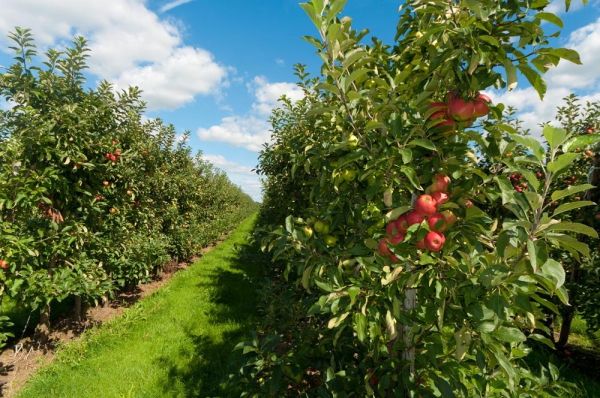
If the site is on a hill, then rows of trees should be placed across the slope.
landscape style looks more natural - trees in nature grow randomly. That is, you can place the crops in any way you want (taking into account the compatibility of plants and other factors that affect their successful growth). This method of planting fruit crops is suitable for uneven areas, with depressions and mounds, since such "shortcomings" of the relief will create the illusion of a natural composition.
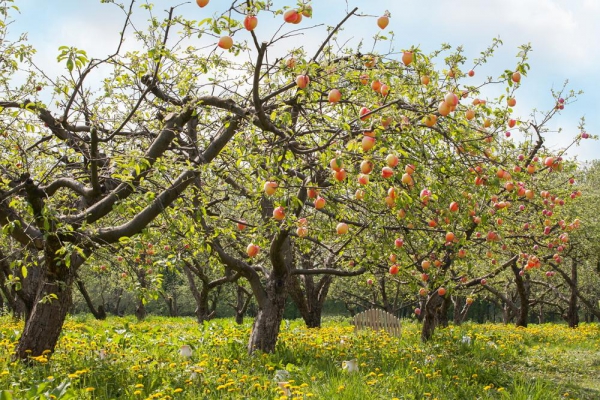
Selection of species and varieties of fruit trees
Once you have decided on the location of the trees and the planting pattern, it is worth considering how many and which plants to plant. To do this, it is best to draw a rough site plan with all buildings and large objects. The selection of species and varieties of horticultural crops should be carried out with the condition that they can pollinate each other.
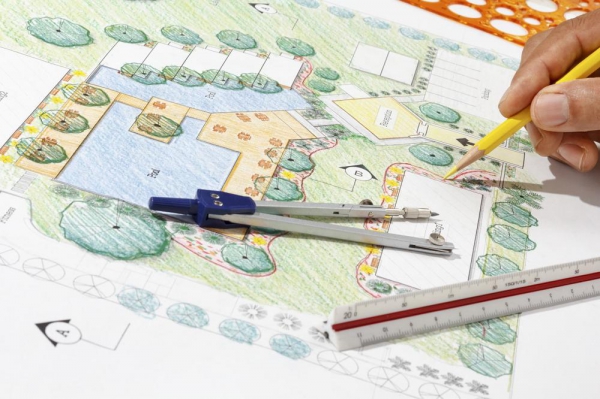
For example, if you are planting apple trees, make sure that more than half of the seedlings are winter varieties. Their fruits will subsequently be stored until spring or even early summer.
The ripening period of the crop is also an important criterion. It is advisable to plant varieties with different ripening dates - this will extend the harvest time.
Distance between trees
In order for crops to have enough space for harmonious development, they must be planted at a certain distance from each other, as well as from buildings. So, cherries and plums should not be located closer than 3 m from the boundaries of the site (as well as from fences and buildings). It is advisable to plant apple and pear trees even further away from them.
The distance between the rows of trees grafted onto tall rootstocks should be on average about 5-6 m. In the rows between crops, a gap of 4-5 m wide should be left. If you plant fruit crops closer, they will begin to stretch ahead of time (they will reach for the sun ), their productivity will decrease, and the quality of the crop will deteriorate.

If you plan to plant trees with a small-sized crown, the distance between them can be reduced by 0.5-1 m. With mixed placement of fruit trees and berry bushes, the distance between crops in rows should be increased by 1-2 m, and between rows - by 1- 1.5 m
|
culture |
Distance between rows (m) |
Distance between plants in a row (m) |
|
Cherry tall |
||
|
Cherry stunted |
||
|
Pear on a vigorous rootstock |
||
|
Pear on a stunted rootstock |
||
|
Sea buckthorn |
||
|
Walnut |
||
|
Plum tall |
||
|
Plum stunted |
||
|
Apple tree on a vigorous rootstock |
||
|
Apple tree on a stunted rootstock |
When to plant trees: autumn or spring?
Usually, trees are planted or transplanted only when they are at rest: in spring or autumn. In summer, such a procedure is unsafe, because the plants are in the midst of the growing season. And if you disturb a young tree at this time, then after the stress it has suffered, it runs the risk of getting sick or even dying. How to determine in which season it is right to plant trees? The choice depends on the climate zone.
|
Region |
Time of planting (transplanting) trees |
|
Southern regions |
Trees are planted autumn. Seedlings planted in the spring run the risk of not having time to take root before the onset of hot weather. Therefore, they can get bark burns or die from a lack of moisture in the soil. |
|
Central regions |
Trees can be planted as spring, and autumn. Regardless of the time of planting, the result will be approximately the same: in a temperate climate, seedlings of fruit crops will take root safely. |
|
Northern regions |
Trees are planted spring. Not too hot spring and summer will allow the plants to adapt and timely leave for winter rest. Fruit crops planted in autumn, on the contrary, will not be able to acclimatize in time and will die with the onset of the first frosts. |
How many trees to plant in the garden?
Usually, each gardener decides this individually, based on the size of the site and their needs. But on average, in order to provide fruits for a family of 3-4 people, it is recommended to plant:
- 3 apple trees of winter varieties;
- 2 apple trees of autumn varieties;
- 2 apple trees of summer varieties;
- 2 pears;
- 4 cherries;
- 4 plums (or 2 plums and 2 cherry plums).
Now that the plan for planting trees in the garden has been drawn up taking into account all the nuances, it's time to start laying the orchard.
DIY garden
Planting a garden is no easy task. But if you follow the basic rules for planting seedlings and caring for them, you will succeed!
Selection of seedlings for
The best place to purchase quality planting material is from seedling nurseries or specialty stores. When buying a tree, carefully consider it. The trunk of the seedling should be 2 cm in diameter, smooth, without sores and damage. The length of the roots is 25-30 cm. Give preference to those trees on the roots of which there is a clod of earth. If the roots are exposed, the tree is likely to be sick for a long time or not take root at all in a new place. The crown of a young tree should consist of three or more well-developed branches at least 45-50 cm long. They are called skeletal.
TIPS
*
Buy varieties adapted to your climate (zoned)
*
When transporting, wrap the root of the seedling with a wet cloth and place it in a plastic bag.
Preparatory work
We mark the site For good development of the crown and root system, there must be sufficient space between the seedlings. Therefore, determine in advance at what distance from each other the trees will grow, and drive pegs into these places. The distance between cherries and cherries should be at least 2 m, plums - at least 3 m, apple trees and pears - about 4-5 m.
Cooking the place. Dig a hole, remove from it all the remains of roots from weeds and previous plants. The size of the pit for plums and cherries: diameter - 70-80 cm, depth - 40 cm; for apple and pear trees: diameter - about 1 m, depth - at least 60-70 cm. Loosen the bottom of the pit to the depth of a spade bayonet. If the land is infertile, add some mineral fertilizer (for example, 150-200 g of bone meal) and a glass of wood ash to the hole. Fertilizer must be applied a few days before planting seedlings. In the center of the pit, drive in a stake 1.2-1.5 m long so that it rises half a meter above the ground.
Planting seedlings in the garden
Cut the roots damaged during transportation or digging to a healthy place. Cut the branches to 1/3 of the length. Pour a mixture of earth with humus into the pit (half a bucket per tree). Form a mound out of it around the stake, put a seedling on it, straightening the roots, cover it with earth. Tie the seedling to the stake. Water generously. For an apple tree and a pear, you need 3-4 buckets of water, for a cherry and a plum - 2-3. When the water is absorbed, add more earth. Fertilize the trees only after shoots at least 10-12 cm long appear on them.
When planting, make sure that the grafting site at the bottom of the trunk is not covered with earth.
Features of growing fruit trees
The health and productivity of fruit and berry crops directly depend on right choice places in the garden. In this case, it is necessary to take into account their requirements for growing conditions.
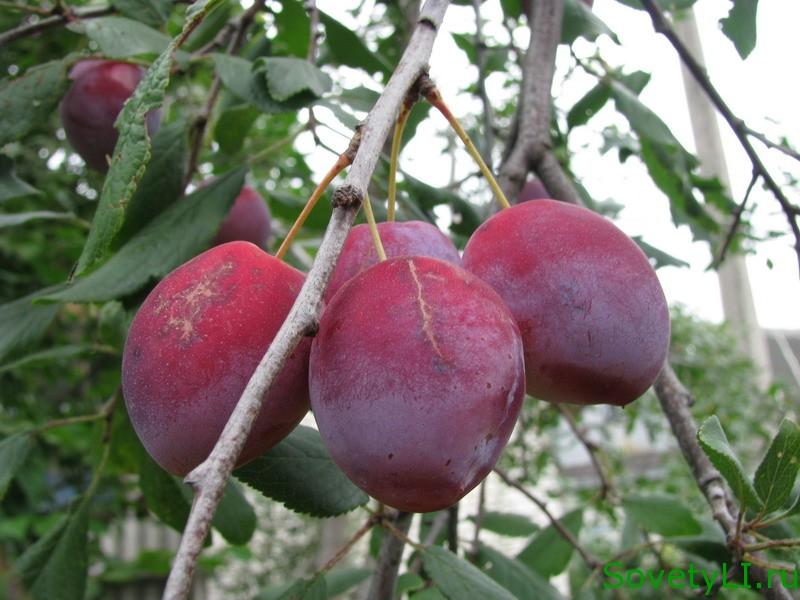 Plum and cherry plum grow on any fertile moist soils, but do not tolerate excess moisture. The depth of groundwater is not closer than 1 m. The place should be sunny and protected from the winds. But cherry plum is more thermophilic. In shaded places with insufficient air circulation, cherry plum does not bear fruit well and is more often affected by fungal diseases.
Plum and cherry plum grow on any fertile moist soils, but do not tolerate excess moisture. The depth of groundwater is not closer than 1 m. The place should be sunny and protected from the winds. But cherry plum is more thermophilic. In shaded places with insufficient air circulation, cherry plum does not bear fruit well and is more often affected by fungal diseases.
 Apple tree considered the most unpretentious fruit tree. It can grow and bear fruit on soils of any texture, both in a sunny place and in shaded corners. But the best soils are loamy, with a well-permeable subsoil, or sandy loamy, rich in humus. This tree does not like low places and hollows where cold air accumulates. The optimal level of groundwater is no closer than 1.5-2 m from the surface. At a higher occurrence, apple trees are planted on artificial hills or ramparts.
Apple tree considered the most unpretentious fruit tree. It can grow and bear fruit on soils of any texture, both in a sunny place and in shaded corners. But the best soils are loamy, with a well-permeable subsoil, or sandy loamy, rich in humus. This tree does not like low places and hollows where cold air accumulates. The optimal level of groundwater is no closer than 1.5-2 m from the surface. At a higher occurrence, apple trees are planted on artificial hills or ramparts.
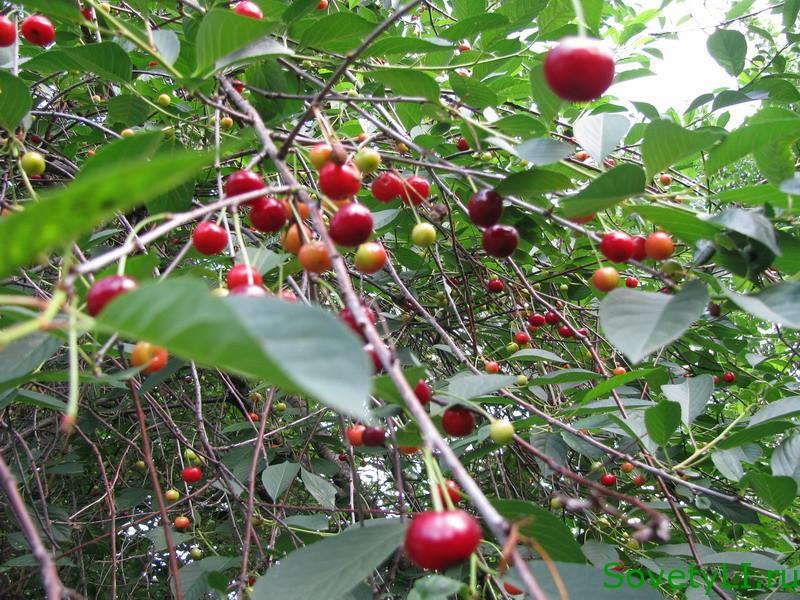
Cherry and sweet cherry require fertile light loams and sandy loamy soils with a neutral reaction of the soil environment. They do well on sandy soils, but grow poorly on clay soils. Cherry does not tolerate waterlogging; for it, groundwater should lie no closer than 2 m from the surface of the earth. Cherries are more moisture-loving than cherries.
These trees love bright light, although they tolerate shading. In the shade, they bear fruit worse, give a meager harvest. In areas with cold winters, it is better to plant cherries only in spring.
Pear prefers sandy and loamy soils, does not withstand heavy clay soils. On sandy soils, the taste of fruits deteriorates sharply. Pear should be planted in warm, elevated places. ground water should be no closer than 1.5 m. It is less winter-hardy than an apple tree, but more drought-resistant.
Apricot- typical southern culture. AT middle lane and Siberia, it is not so much the winter cold that is dangerous for him, but the alternation of thaw and frost in the spring, which damage the blooming flowers. It is better to plant apricots close to buildings so that the tree can receive additional heat from them. The place should be high, protected from the winds. Any sufficiently fertile slightly acidic soil is suitable for it. It grows worse on heavy clay soils.
Water the orchard
In hot, dry weather, the garden needs watering. If there is not enough moisture, this negatively affects the growth of young trees, the filling of fruits and berries, and, consequently, their quality and yield.
July watering has a positive effect on the laying of flower buds for the next year.
Trees are watered over the entire projection of the crown so that the soil becomes wet to a depth of 60 cm.
Under berry bushes during the formation and filling of fruits every 10 days give 3-4 buckets of water.
Why is the orchard not growing?
Planted by all the rules apple and pear trees grow well for the first few years, but then the growth of shoots may stop. Trees begin to grow poorly and bear fruit poorly.
The reason is that the trees do not receive the necessary nutrition, therefore, periodic fruiting and poor growth are observed. The seedlings grew well during the first years, using the nutrients introduced during planting. But when the roots reached the walls of the planting holes and no food was found behind them, the growth of the trees stopped. The fertilizers that you apply are not used by the trees, and if they are used, then in very small quantities, since they do not reach the suction roots.
In order for the trees to develop normally and bear fruit annually, you need to properly feed them. Since the bulk of the roots is at a depth of 35-40 cm, and the suction roots are located along the outer perimeter of the crown, to make top dressing, they dig holes or grooves to this depth along the perimeter of the crown and apply fertilizer there, followed by their powdering with earth. In autumn, organic fertilizers are laid in them, as well as phosphorus and potash, in spring - nitrogen. After flowering, during the formation of ovaries, you can once again give nitrogen fertilizers to the trees in the form of liquid top dressing (liquid, mullein, nettle infusion, urea solution or ammonium nitrate). But it is necessary to make them to the depth of the roots.
Planting a tree at first glance is not difficult: they dug a hole, installed it, dug it in. The survival rate of plants depends on compliance with the technological process and the choice of a place for each seedling. Today we'll talk about how to plant a garden. Let's define best season for planting young animals and figure out how to place the plants relative to each other.
If you do not want to understand all the technical details of landing, we recommend ask for help to professional gardeners. Our experienced specialists for low pay will qualitatively perform all types of garden work: from planting to plant rejuvenation! :)
season selection
First exciting question: how to plant a garden on the site - in spring or autumn. Yes, yes, the choice is exclusively from two seasons. The fact is that plants are planted (replanted) only when they are in a state of dormancy. The exception is large-sized ones - they are usually moved in a state of deep winter sleep. In summer (during the active growing season), it is highly recommended not to transplant young growth from place to place. He is already accustomed to the area where he grows, and will receive a shock from a sharp change in the place of growth, as a result, without having time to get used to the new conditions, he will burn out in the sun or die from a deficiency of trace elements. Almost 100% of seedlings planted in summer time, become a good material for kindling firewood for barbecue.
In total, we return to the question: how to properly plant a garden in the country - in autumn or spring? The choice of season depends on the climate zone.
- In the south lane planting work is carried out in the fall. If seedlings are planted here in the spring, they may not have time to take root before the onset of extreme heat, get burned, and die from moisture deficiency.
- In the north- the opposite situation. Here you need to plant a garden in the spring. During the growing season, they will take root and calmly go into hibernation. Autumn planting is dangerous for plants. Most likely, they will not have time to acclimatize and will die with the onset of severe frosts. Getting frostbite.
- In the central lane You can do planting work twice a year. Here, autumn and spring planting give an almost identical result: young growth takes root well in a temperate climate.
Recall that all garden work you can give away in the hands of professional gardeners. Our experienced specialists know how to properly plant a garden of goji shrubs, apple plants, pear plants, all types of stone fruits, as well as ornamentals.
By the way, when planting a large amount of young animals, it is advisable to prepare a site for planting in advance. On it you need to carry out a whole range of works. It is carried out here: cleaning of the territory, loosening, marking, drainage is installed, all pits are prepared at the same time. Without special equipment, only the preparatory work will drag on for many months. We have agricultural machinery and specialized tools, so we can prepare a large area in a short time.
How to plant a garden: planting scheme
Before proceeding to planting seedlings, it is necessary to create a plan for the future garden. First of all, landing standards are taken into account. Primary requirements:
- The distance from the fruit-bearers to the neighbor's fence is from 3 m or more.
- When planting trees near the house, you need to retreat enough so that an adult tree does not destroy the foundation with its roots.
- When planting young animals, the location of heating mains and the laying of power lines are taken into account.
Now consider, how to properly plant a garden and a vegetable garden relative to each other. Trees are arranged so that as they grow, they do not obscure garden plants. Please note that it is desirable to plant some crops in close proximity to the fruit-bearers. For example, coriander and dill lure entomophages - natural enemies of insect pests. Mustard, rapeseed and legumes can serve as natural organic fertilizer.
When distributing young growth over the site, calculate the minimum step between seedlings. So that adult trees do not interfere with each other, the distance between them should be equal to the sum of their heights, or even more.
Now you know how to properly plant an orchard. As for the technique of planting trees, we advise you to look at individual articles on planting on our website. After all, each culture is unique and requires its own approach when planting: the terrain is selected differently, pits are prepared, fertilizers differ.
How to plant a garden video



